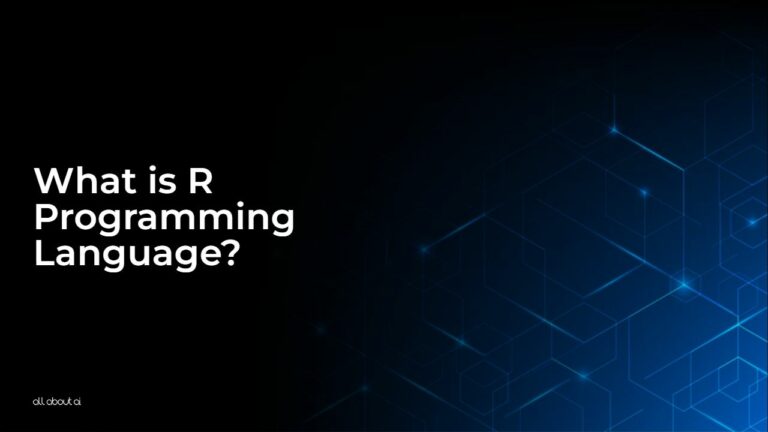What is R programming language? Initially conceived in the 1990s, it has evolved into a fundamental tool in statistical computing and graphics. It’s an open-source programming language, highly favored in data analysis, statistical modeling, and graphical representation.
Looking to learn more about R programming language? Keep reading this article written by the AI aficionados at All About AI.
What is R programming language? Well, it’s like a special computer language that was created back in the 1990s. People use it a lot for doing math and making pictures with numbers. It’s a free language, and many folks like to use it when they want to study data, make predictions, or draw graphs.What is R Programming Language? The Fun Path to Knowledge
How Did R Programming Language Emerge?
This section discusses the history of the R programming language.
The Origins of R
The R programming language’s history can be traced back to the early 1990s at the University of Auckland. Ross Ihaka and Robert Gentleman, both statisticians, began developing R as an alternative to the S programming language, which was used for data analysis and statistical modeling.
They aimed to create a language that was not only free but also offered an open-source environment for statistical computing.
Growth and Community Involvement
As R’s capabilities expanded, it quickly gained popularity within the statistical computing community. Its open-source nature allowed it to be constantly refined and updated by contributions from users worldwide.
This collaborative approach led to the development of a comprehensive package ecosystem, making R one of the most versatile tools for statistical analysis and data visualization.
Establishment as a Statistical Standard
Over the years, R has solidified its position as a standard in the field of statistical computing. Its rich array of packages, ability to handle complex statistical methods, and its graphical capabilities have made it a preferred choice for statisticians and data scientists globally.
What Makes R Programming Stand Out in Data Science?

R’s distinctiveness in data science lies in its robust package ecosystem, superior graphical capabilities, and strong community support.
Robust Package Ecosystem
R’s extensive package ecosystem, hosted on CRAN (Comprehensive R Archive Network), provides tools for virtually every statistical and graphical technique. This vast array of packages makes R incredibly versatile and adaptable to various data science needs.
Superior Data Visualization Capabilities
One of R’s standout features is its powerful data visualization capabilities. Packages like ggplot2 allow for the creation of complex and aesthetically pleasing visualizations, which are crucial for data analysis and interpretation.
Strong Community and Support
The R community is a significant asset, providing extensive support through forums, blogs, and conferences. This community-driven support ensures continuous learning and problem-solving resources for R users.
Tailored for Statistical Analysis
R is specifically designed for statistical analysis, offering a wide range of statistical tests and modeling techniques. This focus makes it a go-to tool for complex statistical computations that are integral to data science.
Who Are the Main Users of R Programming Language?

R is widely used by statisticians, data analysts, and researchers. It’s a go-to tool in academia for statistical research and is increasingly adopted by businesses for data-driven decision-making.
Statisticians and Data Scientists
Statisticians and data scientists form the core user base of R. They utilize its statistical and data analysis capabilities for research, predictive modeling, and data mining.
Academia and Researchers
Academics and researchers extensively use R for statistical studies, particularly in fields like economics, sociology, and biostatistics. Its open-source nature and comprehensive capabilities make it ideal for scholarly work.
Businesses and Market Analysts
In the business sector, R is used for market research, business analytics, and financial modeling. Companies leverage R’s capabilities to analyze consumer data and inform decision-making processes.
Pros and Cons of Using R for Data Analysis
Pros:
- Extensive range of packages for statistical analysis and data visualization.
- Strong graphical capabilities, ideal for creating various types of plots and charts.
- Active community support ensures constant updates and troubleshooting help.
- Open-source nature makes it freely accessible and modifiable.
- Tailored for complex statistical calculations, making it highly reliable in data science.
Cons:
- Steeper learning curve, particularly for those new to programming.
- Slower performance with very large datasets compared to some other languages.
- Less intuitive for general-purpose programming, limiting its broader applicability.
- Memory-intensive, which can be a drawback for large-scale computing tasks.
- Limited support for web applications and other interactive technologies.
How Does R Interact with Big Data Applications?
R’s interaction with big data is facilitated through its compatibility with big data processing platforms and packages designed for large datasets.
It connects with databases like MySQL and big data platforms like Hadoop and Spark, allowing for efficient data processing and analysis. Packages like ‘bigmemory’ help manage large datasets by providing advanced memory management capabilities.
R also interfaces with languages like Java and Python, enabling seamless integration in diverse data environments.
R vs. Python: Which Should You Choose for Data Science?

Choosing between R and Python for data science depends on the specific requirements of the project and the user’s background. R is ideal for statistical analysis and creating complex visualizations, while Python is more versatile, better for machine learning, and easier for beginners.
R:
- Tailored for statistical analysis and data visualization.
- Extensive package ecosystem specifically for statistics.
- Preferred for complex statistical computations and academic research.
- Strong graphical capabilities for advanced data visualization.
Python:
- A general-purpose programming language with strong data science libraries.
- Easier learning curve and broader application beyond data science.
- Efficient in handling large datasets and faster performance in general.
- Better suited for machine learning and artificial intelligence projects.
Enter the exciting world of artificial intelligence with our meticulously designed glossaries. Whether you’re a newcomer or an experienced learner, there’s always something intriguing to explore!Want to Read More? Explore These AI Glossaries!
FAQs
What is the R programming language used for?
What is R vs Python?
Is R and C++ the same?
Is R replaced by Python?
Conclusion
R programming language remains a vital player in the realm of data science and artificial intelligence. Its statistical prowess and graphical capabilities make it an invaluable tool for data analysts and researchers.
This article comprehensively answered the question, “what is the R programming language,” discussing its use in AI. If you’re looking to enhance your knowledge of the world of AI, read through the rest of the article we have in our AI Glossary.





